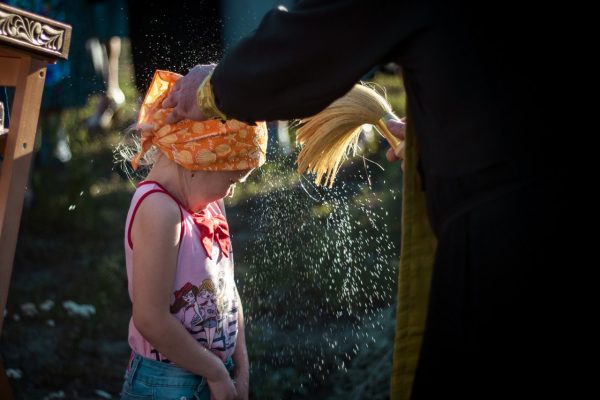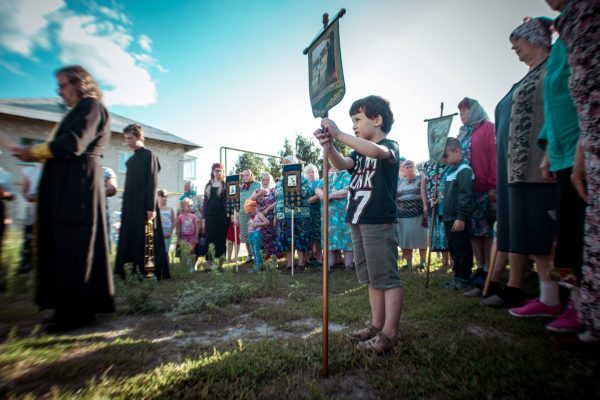If you consult the internet or poll a few parents, you’ll find a wide variety of ideas about how to manage children in church. I’m here to tell you that I’ve mixed it up quite a bit throughout my worshipping career so far. Something to keep in mind is that as a priest’s wife, I’m solo parenting during liturgy, and my toddlers are much more likely to run for the altar to find daddy. This dance might be a little different for your family, and that’s okay. Here are some phases we’ve gone through together, along with some commentary.
1. Sitting at the back
In a few parishes we’ve served and participated in there were many reasons I sat towards the back. Either it was the practice of other parents (and we could all help each other back there), convenient for the many quick exits I had to make with two kids in diapers, or the architecture made it advantageous (one parish didn’t have a narthex into which I could disappear as needed–it simply opened directly to the outside, which was pretty troublesome in winter with a newborn and a toddler). When my second child was fresh out of the oven, the back of the church was a place where I could nurse discretely under a blanket while still singing along to the service and keeping my toddler in check.
Maybe you’re in a place where being towards the back is best. However…
2. Sitting at the front
…as my children have grown older (beginning elementary school), we’ve moved towards the front of the church. With years of weekly liturgical practice they know it’s expected that they stand up for longer periods of time. They are capable for standing more still. And with the beginnings of reading, they can participate. My eldest has even expressed a desire to stand with the choir. The front is quite often an easier place for kids to be because they can see all the icons and all the action–sitting at the back means that they’re looking at other people’s legs, and that’s quite boring. I definitely noticed a higher level of engagement when we made the move towards the front, but it took awhile before we were ready to make that leap, because…
3. Bring books into church
The biggest challenge with very young children is simply to keep them occupied and physically in the service. The things that are happening in the service are simply beyond what young children can understand, but that doesn’t mean that they don’t benefit from every minute of exposure.
Books can help. Bringing a favorite book can keep a child still and help them to learn that liturgy is the normal place for them to sit and be. While they look at the book, they are hearing the prayers, learning the melodies, all in the background of their minds. When they look up from the book, they see the church. It becomes another place of their own. It gives them the opportunity to observe and ask questions.
But I don’t let them bring just any book. Because this isn’t just any service–it’s the service of the Resurrection. This isn’t a place to bring you favorite fantasy fiction novel, but I’m not going to tell my toddler that “Goodnight Moon” can’t be a church book from time to time. Some wonderful books that engage children in the liturgy and teach them about the spiritual life include:
I’ve also cut out the icons from expired paper calendars and laminated them into little books for preliterate chlidren. They may not understand exactly what an icon means beyond the simple concept that they’re pictures of people, but it’s a wonderful way to be able to whisper the lives of the saints into your youngest’s ears. That way the icon become another normal, routine, effortless element of their life.

Photo: https://vk.com/simbirskaya_mitropolia
4. Don’t bring books into church
But then, there’s the distraction part of bringing books into church. Maybe you fight over how many books they’re allowed to bring. Perhaps they drop them–loudly and often. After a time, books became an attention drain I had to manage with my children, rather than a tool I could use when my goal was to keep the kids in the services as much as possible. We slowly transitioned from kids’ books to picking up a book of the liturgy text and so that I could teach them to follow along and pay even more attention to the service. Again, each child transitions at a different rate with this; my toddler needs one or two board books in church, my nearly-literate kindergartener enjoys looking at Bible story books, and my second grader follows along in the liturgy book.
5. Let the kids draw and doodle in church
When my children were very young, the sermon was almost the hardest time for them to sit still and quietly. For one thing, it always seems easier for a kid to listen to someone other than their parents, and so when their father started delivering the sermon, it was almost as though they all decided to act out together in that moment.
It began with letting them draw. Just pen and paper, a few sheets, and it kept them quiet. But I discovered they would lose focus on where they were–drawing scenes of cartoons and goofy things, as kids do. So I told them that if they listened closely to the gospel and sat still during the sermon, they could make a drawing about the gospel’s story. One pen, one piece of paper, no fussing. I’d make them sign and date the drawing so I could connect the gospel reading to their interpretation, and remark on it more in-depth, or show it to their father later. It spurred dialogue. Sometimes, the kids would want to copy the icon of the day, and when we were stuck in the narthex with an outraged baby, they could really study the icon and make it their own.
This worked on days when the gospel was a narrative, and the sermon on the shorter side. Sometimes we had to leave anyway because they were fighting over who had the better writing utensil. But on the days when it worked, they were listening and engaged and created some interesting and thought-provoking art.
6. Don’t bring art supplies into church
Again, like the books, the drawing idea can become a fixation and distraction. Once my children were prone to extending their drawing time, draw things other than what was instructed, fighting over pens and other things, I informed them that they were old enough to listen through the service without the need to draw. Occasionally I do allow continue to allow gospel drawing, since that remains an effective way for them to learn listening skills and process the lesson.
Talk to Your Priest
One of the most important things you can do is talk to your priest and to discuss your plans for how you’re training your children to engage with the liturgy. Sometimes the priest can even offer suggestions for where to sit or stand, or even reassurance that your children really aren’t as loud as you think they are. In many cases, priests I know have said that the noises they hear from time to time tell them that their congregation is healthy and growing–a squawk from a baby is its own wonderful offering of praise when it’s in the middle of worship.
This is especially important if your child has unique developmental needs or even just plain ol’ behavioral struggles. You can work together with your priest to find a way to minister to your child, no matter where they are. And your priest may be able to connect you with a seasoned parent or someone in the parish who can stand with you and help you manage worship and Sunday School. Get your priest on your parenting team.
Be Prepared for Feedback
The arrival of a lone young family to a congregation can be conspicuous and difficult. Sometimes it’s a shock to other worshippers, who are more accustomed to a quieter service. Or perhaps you’re in a large congregation and they don’t know your family very well and thus don’t know how to help your dear little ones on their faith journey. Maybe it’s simply that you’ve been used to doing things a certain way and find that in this new place, folks seem to expect things to go a little differently, and having your kids in tow makes it more obvious. Sometimes, you’re one of many young families, struggling together to get your kids to the service on time, and not to distract one another, but the group energy of the kids can get out of control.
I know many parents who have taken comments from other worshippers and let it keep them from church. This is unfortunate, but it’s important that others know this happens, because they must weigh their words heavily with love. Parents of younger children are especially vulnerable, because they are likely to be early on in their parenting journey and perhaps a little sleep deprived.
But parents, it’s super important that you try not to take any comments personally, and to examine them carefully for good nuggets of wisdom. I struggle in my own way to acknowledge that I could have done better, while simultaneously feeling indignant because I gave it my all on a given Sunday morning. It can feel unjust and intrusive to have someone offer even constructive criticism, when what they’re criticising are often inherently irrational and unpredictable beings that you are training to become (somewhat) civilized.
Feedback–positive or negative–is going to happen. Prepare yourself. Don’t take it personally, but listen to it patiently and prayerfully. Some useful phrases I have in my back pocket for dealing with difficult comments are,
“Thank you for reminding me, we’re in the process of learning.”
“I’m sorry to hear that my children’s behavior was a distraction to you.”
“Church is full of challenges for children.”
These phrases can feel sort of weak and general, but I know they’ve helped me depersonalize and prevent myself from becoming defensive, as well as keeping more pointed inquiries at bay (very few others really needs to know the details of exactly what my child was doing or frustrated with).
But honestly more often than not I’ve had feedback from people who simply love that they heard a few noises from a baby in church. And sometimes the horrified face you get when your toddler makes a run at the altar is mirrored by a joyful smile on the other side of aisle (not that you want that to happen over and over again). I’ve had feedback from people who are genuinely worried that things are okay with my kids, and have asked if I need help. When that happens, it’s enabled me to come to a place where I feel comfortable asking them for help.

Photo: https://vk.com/simbirskaya_mitropolia
Ask For Help
This is easier for some than others. Perhaps you’re in a situation where you don’t know many people from the parish, or your child has special developmental needs that require a good deal of coaching. It’s especially important that you make your needs known to others, so that they can help you and worship doesn’t feel like a battleground (although there are some seasons where it’s likely to feel nothing but). This is difficult, because perhaps you’re embarassed or you feel particularly alone in your fight. But what you have to say is important–your voice may be the thing that gets the community involved in making things accessible for children and those with developmental or physical challenges. And don’t forget: other people want to be needed and useful, and you have a gift for them–an opportunity to be important, needed, helpful, and involved.
Last Words
Young children genuinely can’t stand for hours on end. Let them be children. Don’t make them stand still out of fear of you. Coax that skill like growing a plant. It will look dormant for a long time, but keep watering it, and a sprout will appear. Have hope. Listening looks different for every child. Sometimes they look bored. Sometimes they’re drawing. Sometimes they actually look like they’re listening. Let them listen their own way, but teach them what behavior tells others that they’re listening–that’s a different skill. Take breaks and gather your strength. Keep trying new things. What you found worked yesterday may not work on this day. Don’t despair. And kids have unbounded curiousity, so ask them questions to keep that going. If they learn the why, the what will make sense and it will become embedded in their hearts.
The purpose is not to have perfectly behaved children in church. As parents, we’re playing the long game–our purpose is to pour love into their open hearts, and help the seeds of faith grow slowly over time. With consistency and ingenuity, we can help them do just that.



















